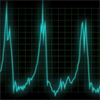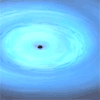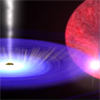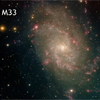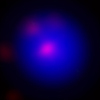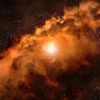CXC Home | Search | Help | Image Use Policy | Latest Images | Privacy | Accessibility | Glossary | Q&A
1. Simulation of GRS 1915's "Heartbeat"
QuicktimeMPEG This movie shows a simulation of the heartbeat variation of GRS 1915. It shows an X-ray point source varying with time, based on an average X-ray light curve of GRS 1915 obtained with RXTE. The period of the heartbeat variation has been sped up by a factor of 10 and four cycles of the variation are shown.
[Runtime: 0.20]
(NASA/CXC/Harvard/J.Neilsen & A.Hobart)
Related Chandra Images:
QuicktimeMPEG This movie shows a simulation of the heartbeat variation of GRS 1915. It shows an X-ray point source varying with time, based on an average X-ray light curve of GRS 1915 obtained with RXTE. The period of the heartbeat variation has been sped up by a factor of 10 and four cycles of the variation are shown.
[Runtime: 0.20]
(NASA/CXC/Harvard/J.Neilsen & A.Hobart)
Related Chandra Images:
- Photo Album: GRS 1915+105
2. Animation of Black Hole Formation in SN 1979C
QuicktimeMPEG This animation shows how a black hole may have formed in SN 1979C. The collapse of a massive star is shown, after it has exhausted its fuel. A flash of light from a shock breaking through the surface of the star is then shown, followed by a powerful supernova explosion. The view then zooms into the center of the explosion. Red, slow-moving material in a disk is shown falling onto the white neutron star that formed when the star collapsed. The rate of infall onto the neutron star increases until the star collapses into a black hole. Matter should continue to fall into the black hole and generate bright X-ray emission for many years.
[Runtime: 00:20]
(NASA/CXC/A.Hobart)
Related Chandra Images:
QuicktimeMPEG This animation shows how a black hole may have formed in SN 1979C. The collapse of a massive star is shown, after it has exhausted its fuel. A flash of light from a shock breaking through the surface of the star is then shown, followed by a powerful supernova explosion. The view then zooms into the center of the explosion. Red, slow-moving material in a disk is shown falling onto the white neutron star that formed when the star collapsed. The rate of infall onto the neutron star increases until the star collapses into a black hole. Matter should continue to fall into the black hole and generate bright X-ray emission for many years.
[Runtime: 00:20]
(NASA/CXC/A.Hobart)
Related Chandra Images:
- Photo Album: SN 1979C
3. Animation of Jet and Wind around GRS 1915+105
QuicktimeMPEG This animation shows how radio jets may be suppressed in the micro- quasar GRS 1915. Material is being pulled from a red companion star into a black hole via a blue, rapidly rotating disk. The animation begins with a jet blowing material away from the black hole. Later, when the disk is heated by powerful radiation from close to the black hole, a wind is driven off the disk. As the wind strengthens, the jet apparently is shut down because the wind deprives the jet of material that would otherwise have fueled it.
[Runtime: 0.25]
View Stills
(NASA/CXC/A.Hobart)
Related Chandra Images:
QuicktimeMPEG This animation shows how radio jets may be suppressed in the micro- quasar GRS 1915. Material is being pulled from a red companion star into a black hole via a blue, rapidly rotating disk. The animation begins with a jet blowing material away from the black hole. Later, when the disk is heated by powerful radiation from close to the black hole, a wind is driven off the disk. As the wind strengthens, the jet apparently is shut down because the wind deprives the jet of material that would otherwise have fueled it.
[Runtime: 0.25]
View Stills
(NASA/CXC/A.Hobart)
Related Chandra Images:
- Photo Album: GRS 1915+105
4. Images of M33 X-7
QuicktimeMPEG This sequence begins with a wide-field optical image from Kitt Peak of M33, a spiral galaxy about 3 million light years from Earth, and then zooms into a view from the Gemini telescope on Mauna Kea, Hawaii. Next, the view zooms into an even smaller field, from the Hubble Space Telescope, that includes M33 X-7, the most massive known black hole to be formed from the collapse of a star. The final image is a composite of the region around M33 X-7 that contains both the Chandra and Hubble data.
[Runtime: 0:35]
(Kitt Peak: NOAO/AURA/NSF/T.A.Rector; Gemini: AURA/Gemini Obs./SDSU/J.Orosz et al.; HST: NASA/STScI/SDSU/J.Orosz et al.; Chandra: NASA/CXC/CfA/P.Plucinsky et al.)
QuicktimeMPEG This sequence begins with a wide-field optical image from Kitt Peak of M33, a spiral galaxy about 3 million light years from Earth, and then zooms into a view from the Gemini telescope on Mauna Kea, Hawaii. Next, the view zooms into an even smaller field, from the Hubble Space Telescope, that includes M33 X-7, the most massive known black hole to be formed from the collapse of a star. The final image is a composite of the region around M33 X-7 that contains both the Chandra and Hubble data.
[Runtime: 0:35]
(Kitt Peak: NOAO/AURA/NSF/T.A.Rector; Gemini: AURA/Gemini Obs./SDSU/J.Orosz et al.; HST: NASA/STScI/SDSU/J.Orosz et al.; Chandra: NASA/CXC/CfA/P.Plucinsky et al.)
5. Comparing Different Black Holes
QuicktimeMPEG Broadcast:
This sequence shows four black holes from the Bootes field. The first two black holes are obscured by thick rings of gas. Because such a ring blocks certain types of radiation, these black holes are only are seen in X-ray (blue) and infrared (red) light. The last two black holes are not enshrouded by this ring of material, and, therefore, emit X-ray, infrared, and optical (green) radiation. These objects helps astronomers better understand the properties of these monster black holes.
[Runtime: 0:08]
(X-ray: NASA/CXC/CfA/R.Hickox et al.; Infrared: NASA/JPL/Caltech/P.Eisenhardt & D.Stern et al.; Optical: NOAO/B.Jannuzi & A.Dey et al.)
Related Chandra Images:
QuicktimeMPEG Broadcast:
- QuickTime movie (uncompressed)
- D1 (0.9 pixel aspect ratio)
- 720x486
- 29.97 fps
- file size = (17.2 MB)
This sequence shows four black holes from the Bootes field. The first two black holes are obscured by thick rings of gas. Because such a ring blocks certain types of radiation, these black holes are only are seen in X-ray (blue) and infrared (red) light. The last two black holes are not enshrouded by this ring of material, and, therefore, emit X-ray, infrared, and optical (green) radiation. These objects helps astronomers better understand the properties of these monster black holes.
[Runtime: 0:08]
(X-ray: NASA/CXC/CfA/R.Hickox et al.; Infrared: NASA/JPL/Caltech/P.Eisenhardt & D.Stern et al.; Optical: NOAO/B.Jannuzi & A.Dey et al.)
Related Chandra Images:
- Photo Album: XRF 060218
6. Animation of Eruption from Supermassive Black Hole
QuicktimeMPEG Broadcast:
This animation depicts an eruption caused by a supermassive black hole. Gas and dust (reddish-brown disk) are being pulled around by the enormous gravity of the supermassive black hole, which is buried in the center of a large elliptical galaxy. The animation then zooms out to show the full view of the galaxy, which is surrounded by hot gas (red) that pervades the galaxy cluster. White jets, fueled from material falling onto the black hole, then erupt from the black hole and push gas backwards to create the dark cavities in the cluster gas.
[Runtime: 0:17]
View Stills
(NASA/CXC/A.Hobart)
Related Chandra Images:
QuicktimeMPEG Broadcast:
- QuickTime movie (uncompressed)
- D1 (0.9 pixel aspect ratio)
- 720x486
- 29.97 fps
- file size = (417.4 MB)
This animation depicts an eruption caused by a supermassive black hole. Gas and dust (reddish-brown disk) are being pulled around by the enormous gravity of the supermassive black hole, which is buried in the center of a large elliptical galaxy. The animation then zooms out to show the full view of the galaxy, which is surrounded by hot gas (red) that pervades the galaxy cluster. White jets, fueled from material falling onto the black hole, then erupt from the black hole and push gas backwards to create the dark cavities in the cluster gas.
[Runtime: 0:17]
View Stills
(NASA/CXC/A.Hobart)
Related Chandra Images:
- Photo Album: MS 0735.6+7421


